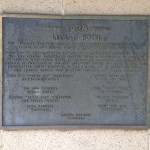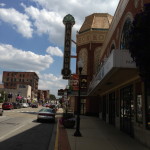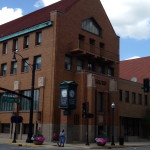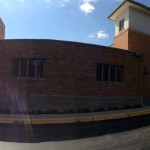By Dan Kelly
Steve Salter praises forgotten men.
For some 20 years the Michigan resident has made a mission to provide headstones for deceased bluesmen with unmarked graves. Blazing a thin trail through the Midwest, the sixtyish blues fan has helped mark the last resting places of performers like Otis Spann, Big Maceo Merriweather, “Hound Dog Taylor“, Washboard Sam, Charley Jordan, and others. But for every one commemorated, more remain, still laying unknown in the earth. Salter wants to rectify that by leaving markers at all his musical heroes’ gravesites.
“I just want to see that they get proper recognition,” he explains by phone. “Lying in an unmarked grave is not proper recognition.”
*****
Death and the blues are inextricably linked. Within every blues musician’s repertoire—amidst the howls, growls, notes, and chords about wicked women, bad booze, life’s cruelty, and more—lurks the Grim Reaper. But no matter how bad a bluesman was (or how bad he claimed to be), many begged that their mortal remains be treated kindly. Supposed satanic soul-seller Robert Johnson pled to be buried by the highway, allowing his “old evil spirit” to catch a Greyhound bus. Blind Willie McTell’s rounder in “Dying Crap-Shooter’s Blues” requested that his grave be dug with the ace of spades, a deck of cards serving as his tombstone. Down in Texas, Blind Lemon Jefferson plaintively asked that his grave be kept clean. As it stands, Lemon’s and others’ pots have yet to be located, much less maintained. All the more reason why Salter and kindred spirits have made it their business to find and mark those we do know about.
Music looms large in Salter’s life. He shared one particularly sharp childhood memory of falling asleep while listening to his “grandfather’s old radio with the green eye.” First experiencing the blues the way most white Baby Boomers did—the British Invasion—he followed a liner note trail and discovered names like Willie Dixon, Sunnyland Slim, and Muddy Waters. Record store excavations led to new discoveries, and soon he was hooked. After years of ollecting music and attending shows, Salter founded Killer Blues, selling CDs and t-shirts on the blues festival circuit, while maintaining his day job designing parts for an car factory in Whitehall, MI.
A 1997 road trip to the New Orleans Jazz and Heritage Festival inspired the gravestone project. Salter took the scenic route, stopping in Chicago to pay homage to his favorite performers who’d passed on. Visiting a pre-scandal Burr Oak Cemetery—last resting place of Otis Spann, Willie Dixon, Dinah Washington, Emmet Till, and other African-Americans of note—he was shocked to discover Spann’s grave unmarked.
“I couldn’t understand how somebody who I thought was huge in the blues wouldn’t have a headstone,” Salter told me by phone. That same day he drove a short distance west to Restvale, another black cemetery housing the remains of Muddy Waters, “Hound Dog” Taylor, Magic Sam, and others. Waters’ modest gravestone—a simple granite marker bearing his real name, McKinley Morganfield, and a picture of a guitar—surprised him, but he was more disturbed at the absence of any memorial for Taylor, an idol of his. Salter made his way to New Orleans, pondering what he’d seen. After the festival, he returned home to Whitehall and fired off a letter to Blues Review magazine about Spann’s lack of a marker. Blues Review’s readers and editors agreed it was an onerous omission. Money flowed in from across the globe, and a stone was purchased, etched with a keyboard and sporting the epitaph:
“Otis played the deepest blues we ever heard
He’ll play forever in our hearts”
They held a ceremony and a marker was laid, and for many of the participants that was that. But not for Salter:
“I couldn’t stop. I found too many guys who didn’t have markers, and so I vowed to do something.”
Salter’s next honoree was “Hound Dog” Taylor. A fixture on Maxwell Street and in West Side blues clubs during the 50s through the 70s, the Hound played slide on cheap Japanese electric guitars, and had an extra finger on his left hand to boot. He passed in 1975. While not a household name, he was one of Salter’s idols, and he called the guitarist’s label, Alligator Records, reaching owner Bruce Iglauer.
“[Iglauer] thought that there was a stone, and apparently it never got placed. And so we talked back and forth and Hound Dog eventually did get his headstone.” No ceremony was involved this time.
The more contemporary a performer, the easier it is to find his last resting place. The Internet, of course, has simplified the lives of tombstone tourists—people who enjoy visiting cemeteries—through sites like Find a Grave and Dead Blues Guys. But not every blues performer has been located and marked. Records have been lost, memories have grown fuzzy, friends and family members have died themselves, and oftentimes a bluesman was simply planted in a potter’s field or old churchyard and forgotten. Word of mouth in the music community powers Salter’s searches. Salter cites Chicago piano player Erwin Helfer as a source. The two met some time ago when Salter sent him a letter asking about drummer Odie Payne.
“Whenever I meet any musician, especially in Chicago, the first thing I do is ask him, ‘Do you know where this guy is buried?’ Erwin doesn’t have an e-mail. He has a Web site but he doesn’t have an e-mail. So, the only way you can communicate with him is via snail mail. So I sent him one of my calendars and a short little letter saying who I was and [does he] know where any of these individuals are located?”
Three months later, Helfer wrote back. He wanted to help but didn’t know where any of Salter’s subjects were, though he did know Payne’s daughter. He passed along her phone number. Salter called over the course of a month, eventually reached her, and outlined his intentions to honor her father. She appreciated the gesture, but explained that Payne already had a headstone, and directed him to where it was located.
“That’s very rewarding too,” says Salter. “Here’s another guy that’s no longer lost. At least, to me he was lost, because there didn’t seem to be any information out there that I could get a hold of… I was there last week at the cemetery and took a photograph of the headstone.” Mr. Payne rests at Oak Woods Cemetery on Chicago’s South Side, in good musical company with Little Brother Montgomery, Junior Wells, and Georgia Tom Dorsey.
Big Maceo Merriweather’s grave was his first challenge. The WWII era singer and pianist passed away in 1953, seven years after a stroke ended his career at age 48. Salter located Merriweather in Detroit Memorial Cemetery in Warren, MI. Salter took a methodical approach that he sticks with to this day. On a cemetery expedition he’ll befriend the groundskeepers and office workers, asking if they’re aware of a performer’s location. Speaking with the Detroit Memorial Cemetery people about setting up a gravestone, but a new concern arose.
“It always can be a touchy thing because I’m not family… First we have to see if we can find family, and I have yet to find family for any of the ones that I’ve purchased stones for.”
Usually, he’s asked to sign a waiver stating that if a family member appears and objects to a marker, the stone has to go. “I’m fine with that,” said Salter, adding, “It hasn’t happened yet.”
After two years of work and negotiations, Salter was permitted to place Big Maceo’s headstone. During that time he searched and traveled further. More turned up. In Chicago there was Walter Vinson of the Mississippi Sheiks at Holy Sepulcher in Hillside, IL; Luther Tucker, back in Restvale Cemetery; and so on. The project continued to grow. Killer Blues switched from being a small-time business to a nonprofit foundation in 2005. Alongside getting familial and cemetery officials’ approval, the project faces another ongoing challenge: raising money. One way to raise dough is a yearly calendar featuring gravestone photos sold on the Killer Blues site. Salter also brings in cash by hosting blues shows in his hometown, starring local performers. The project has done well enough to place 53 markers in the past dozen years
Once permission is acquired, creating and placing the stone is a collaborative process with the cemetery personnel. With Washboard Sam, buried in Washington Memory Gardens Cemetery in Homewood, IL, followed the pattern. First, found it was best to buy locally.
“Most often the cemetery has a connection to someone who makes stones,” he explains. “I ask them who would they prefer that I use for this stone. And they’ll go, ‘Oh, we deal with this person,’ and I say, ‘Okay, then that’s who I will deal with.'”
The stones lack frills, sticking to a basic combination of name, birth and death dates, either a nickname or the designation “BLUESMAN,” and an appropriate graphic. Most get guitars or keyboards. Johnny “Daddy Stovepipe” Watson, and “Stagger Lee” inspiration/murderer “Stag” Lee Shelton received their trademark chapeaus—Watson a top hat, and Shelton a Stetson. Robert “Washboard Sam” Brown got a washboard topped by…a round thing.
“Generally, I have a design in mind. With Washboard Sam—if you’ve seen any of the one or two pictures of him out there—he’s holding a washboard that has a circle on it. I don’t know if it’s some kind of a resonator or what, but I wanted that washboard on his headstone. So, I presented a hand drawing and said this is kind of what I want.”
He refers to the stones as “entry-level.” Flat, modest, granite, and a uniform size of 12 inches by 24 inches by 4 inches thick, Salter guesstimates a typical cost of about $800. Washboard Sam’s was $835.16. When the stones are placed, Salter does it with little fanfare. He’ll drive a stone to a cemetery, but usually doesn’t stay to see it placed. While celebrating performers, he has no interest in the limelight.
The first time we spoke, I asked Salter if he knew of anybody else doing this kind of work, and if he interacted with them. No. For many years it was just him, his wife, and a few friends.
“I did talk with people from the Detroit Blues Society, because there’s a number of blues artists in the Detroit area that don’t have headstones. One of them was Calvin Frazier. I’ve talked to them about that and they’ve taken it upon themselves to have a fundraiser to get a headstone for him.” (The stone has since been placed).
There are others. For example, Arlo Leach of Portland, OR, a website designer and jug band performer aficionado. Leach raised money with benefits at the Old Town School of Folk Music for gravestones for Will Shade (Shelby County Cemetery in Memphis, TN) and the McCoy brothers, Papa Charlie and Kansas Joe, (resting in Restvale Cemetery under their newly provided stones).
Like Salter, I have a mania for visiting graves, and 10 years ago I made a road trip to the Deep South for barbecue and dead blues performers. Throughout the Delta I saw several stones arranged by the Mount Zion Memorial Fund. Formed by Skip Henderson in 1989 to prevent foreclosure on the Mount Zion Church in Morgan City, MS, and to raise a cenotaph to Robert Johnson (supposedly buried there, but no one knows for sure), the fund has gone on to provide markers for Charley Patton, Elmore James, Memphis Minnie, Mississippi Fred McDowell, Tommy Johnson, and others. The fund isn’t just about grave markers. It’s about preserving southern African-American culture and history. Over the decades, black churches and their graveyards were slowly appropriated by surrounding white landowners, plucked of stones, then plowed under or paved over. On my own expedition through the Mississippi Delta, my favorite prewar bluesmen required some roadwork to reach. With Charley Patton’s grave (kindly paid for with a donation from Creedence Clearwater Revival’s John Fogerty) I found myself standing in a dusty field, stripped of crops and wispy with red soil and dry grass. A few ordinary basic and homemade stones surrounded Patton’s taller one, which simply indicated he was buried around there…somewhere. The Mount Zion Memorial Fund and its gravestones make a sharp point on the cultural landscape as well, reminding people about what’s been lost and who’s been ignored, even as the modern world profited from the music generated by the region.
*****
Compared with Salter’s honorees, Patton, Johnson, and the other original Delta bluesmen are untouchable historical wraiths floating through Greil Marcus’ Old, Weird America (a phrase I think I’m required by law to mention in an article like this)—real-life, tall-tale figures on par with Johnny Appleseed and John Henry. Salter’s subjects are different. He deals not with legendary revenants, but rather post-Great Migration performers. Semi-famous musicians’ musicians and respected sidemen who played night clubs and worked day jobs, with life stories noticeably lacking in satanic pacts.
With the exception of Burr Oak—one deeply hopes—urban and suburban blues performers’ graves, whether marked or unmarked, remain intact and undisturbed. Compared with the Delta, they’re more accessible too, concentrated in the city’s South Side and southwestern suburbs. Still, it’s doubtful they’re tourist draws for anyone but the most devoted fan. My son and I made a trip to Washboard Sam’s grave several years ago on a chill bastard of a winter’s day when he was two years young. We arrived and I snapped my shots, and within a minute he asked in begging, broken toddler language, “Back in car now?” I agreed. Our tribute was brief, but it was something. Which seems to be Salter’s goal.
Do the bluesmen appreciate Salter’s work and sacrifice? Don’t be ridiculous—they’re dead. Do their families appreciate it? The few living descendants Salter has encountered have been amenable, but most performers without markers invariably had no families to mourn and memorialize them, and probably lacked the funds. Salter’s work is for fans like himself. Gratitude motivates Salter, though he worries that he might be seen as putting on airs, or shaming those who might have provided stones, but didn’t.
“My goal’s not to embarrass anybody or to put anybody down for what they’re not doing. And somehow it calls attention, at least in my mind, that…there’s a lot of Chicago blues guys that don’t have stones. And there’s a lot of Chicago people making money off the blues that could easily do this. But…” He pauses. “I don’t try to judge why other people aren’t doing what they’re doing, or doing what they are, I’m just trying to do what I’m doing.”
“I’ve been pretty fortunate in my life and this is a way for me to give something back. It makes me feel good and I tell people that I do that and I suggest that they find a way to give something back in their life. Irregardless of what the purpose is, but find a way to give something back. Make the world a better place for all of us.”
Note: My apologies to Steve for the unconscionably long delay in writing this. I had some writer’s block issues these past few years. That’s an essay all by itself.































































































































































































































